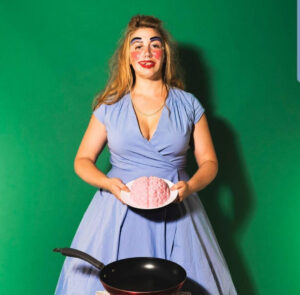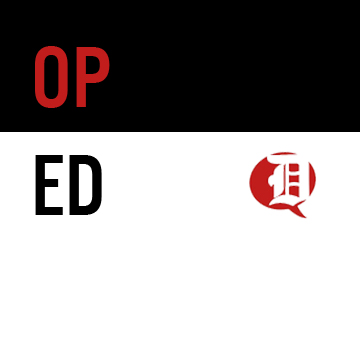
A still from a promotional video for Wild’s show.
Sean Armstrong | Staff Writer
10/17/19
How many people look in the mirror and see something they don’t like about themselves? How many people get a bad grade on an exam and think they’re stupid? How many people are talking to someone and wonder if that person enjoys talking to them? Too many to count.
In her latest art show, Toxic Thoughts, at Iron City Circus Arts in the South Side this Saturday, Mariah Wild, a photographer, videographer and painter is exploring that thought process – where tiny thoughts snowball into part of how people identify themselves.
“[Negative thought processes] started with just a small thought that crosses your mind, day to day, that you don’t think about actively that just grows and grows into a bigger more ominous thought until it manifests into a bigger more ominous thought that becomes your lifestyle or just predominant way of thinking,” Wild said. “So it can be something small ‘I feel fat today,’ and then it just grows into ‘oh, but you’re fat every day.’”
While this is something that many people experience on some level, for Wild the context of this takes on unique struggles below the surface. Wild was diagnosed with bipolar disorder in her teenage years, and has found art to be the only outlet of expression in her depressive phases.
“And then you kind of go off to college and you discover who you are, and you’re like ‘oh no! Am I actually this person?’ and then you discover art, and you’re like ‘oh, I can just get it out that way,’” Wild said.
While art and self-expression can be a great coping mechanism for dealing with any form of hardship, for Wild, art became integral to her mental health.
“And sometimes I used to go through phases or dark periods, as I call them, where if I hadn’t painted what I’m feeling … it almost feels like a poison that’s just killing you slowly. So then you just make something and it eliminates it,” Wild said. “The whole point of this show is just putting it out there so that I can move on from that.”
The goal of this show is not simply to display art but to allow Wild to depict her reality in contrast to the conflicting reality everyone else sees.
“I’m very aware that there are two different realities. There’s this one with all the art, and the negative thoughts and everything else. And then there’s the actual reality where you’re not a terrible person,” Wild said.
According to the World Health Organization, bipolar disorder “typically consists of both manic and depressive episodes separated by periods of normal mood. Manic episodes involve elevated or irritable mood, over-activity, pressure of speech, inflated self-esteem and a decreased need for sleep. People who have manic attacks but do not experience depressive episodes are also classified as having bipolar disorder.”
In the past, bipolar disorder has gotten the best of Wild, specifically during her depressive phases.
“[My negative thoughts] will build up for six months and then I’ll be like, ‘You know what I don’t want to talk to anyone, I don’t want to do anything, I’m just gonna hide out and paint for a while and whatever happens, happens.’”
According to Wild, she experiences her manic episodes like a hamster running on a track.
“It almost feels like it’s just two different frames of mind. There’s the going, I call it the hamster wheel and I’ve done some art on it for the show. It’s just where you constantly need to be going all the time and that’s generally when you feel most like yourself because you’re like ‘I’m doing stuff. I’m helping. I’m collaborating. I’m working with other artists,’” Wild said, “But it’s almost to a harmful extent because you’re not taking care of yourself, you forgot to eat today. I haven’t slept in three days, but you know what? I’m doing great. It’s when you start talking fast, really clearly. That’s hamster wheeling.”
With these conflicting states in mood, it is understandable that negative thoughts can be amplified and taken up as part of a person’s identity more quickly. Wild can see this occurrence in the lead up to her show.
“What I’ve found is doing it publicly, anything that is said to you almost validates the internal monologue. So you’ll have a thought that’s like ‘oh, I’m not good enough.’ and then someone will be like ‘I can’t make it to your show that day.’ That is nothing personal against you, but suddenly your world’s like ‘oh, it’s cause my art sucks.’ It’s like ‘oh, you got me again. Thanks, toxic thoughts,’” Wild said. “ So, this has been a battle, honestly. Next time I’m picking a happier topic like puppies or something.”
On the flip side, even if someone says something positive about the show, the negative thoughts can be identity formations that affect her perception of the good things too.
“It’s something I’ve never experienced … you have people telling you ‘oh, I’m excited for your show.’ Suddenly, you place your bar like up here and you’re like ‘oh, it’s gonna be terrible you shouldn’t be excited.’ It’s a constant circle,” Wild said
Still, as much as these opposing emotional poles can pull a person from happy to sad in an almost inexplicable manner, Wild still sees her show as a positive influence on her mental health.
“[The show is a] huge sense of accomplishment, as weird as it is. One, because you did something productive and you didn’t let [bipolar disorder] get to you. You know, it’s almost like a power struggle,” Wild said. “You can either [be] completely going down this path and just letting it get darker and darker but every time you purge this artwork out it’s like finding your way back out or even just taking a quick little vaccination to get it taken care of. So, that’s the main feeling. When you get it out just a huge sense of relief.”
This hope for herself extends to what she wants those who come to the show to experience, as well.
“I think what I hope they experience, and [what] I tend to experience after I do that artwork, is it’s now real. It’s a very exaggerated feeling and in the past, I’ve had people see some works of art and say ‘oh, I relate to that,’” Wild said, “So, it’s a sense of comradery in the sense that this isn’t a real thing. There’s nothing coming after you, it’s all in your head. The characters and things you’ll see there aren’t real, basically. It’s just all your inner demons trying to get you.”
Those same demons serve not only as the theme for the show but the motivator to host the show.
“I would definitely say it’s fear. That’s a big thing … I’ve had feedback, and it’s other people being like ‘you don’t hustle, you don’t work, you don’t…’ It’s not a great mentality to have. I’ve obviously addressed it, but if you don’t start anything then you can’t fail at it,” Wild said. “I’ve always been a pretty big perfectionist. I like succeeding. So, I’m like, ‘you know what, I’ll help with other people’s things because if that goes wrong it’s not my name on the line.’ It’s not procrastination, it’s fear.”
In the past, this has led Wild to not take chances on her own work and instead let others take the lead artistically.
“Ironically, it was a build-up of all the negative thoughts in that I don’t do anything ever. I like to help other artists collaborate and I’ve never done my own thing … since I started art,” Wild said.
“I’ve always worked for other people. I’ve been doing their stuff. The few times I have done things for myself it’s kind of been, I guess we’ll say, a lazy attempt. So … if I had to do one thing … if I were to die next year for some reason, and I would want to be proud of one thing, it would be fully showing something that I’ve done. And I thought that since I’ve been struggling with this for so long and it’s so personal to me I’m like, ‘you know what, I could probably do that justice.’”
Once again these tendencies not only play into negative thought patterns like fear but are also dictated by the mental states of bipolar disorder.
“What you do is pack your schedule with so many things that you actually set yourself up to fail. … You don’t have to think about anything because you’re moving, you’re going. Then you can justify it’s not laziness because you’re working, but you’re still not putting forth what you want to be putting forth,” Wild said.
To counteract her self-sabotaging, Wild, like many people, made a pact with herself to overcome her self-doubt and mental conditions.
“It’s almost like the same with any New Year’s resolution. Everyone says they’re going to start going to the gym and it’s a month later and maybe we’ve gone a couple of times. I think that’s been the case in the past,” Wild said. “I’ve done little projects here and there and when they didn’t quite come out how I wanted or they’re not up to par it’s like ‘well, nevermind.’ You thought about it too much and you acted a little bit and then it just fizzles out.”
What serves as the most interesting part of this endeavor is how Wild used her own willpower and her support network to get the show over the line.
“I did what I thought was a smart idea at the time, but it turned out to be a huge stressor … I started telling people about it first before I had any plans,” Wild said.“You know, you now publicly look like an idiot. I basically used public shame as a motivator, which I don’t recommend. It worked in this case, but I think moving forward after this is executed, the momentum and I know what it takes is there.”
No matter what happens, Wild is trying to stay positive.
“Last year on my birthday, I was like ,‘I’m going to do this.’ My birthday is on Oct. 19. And I was like, ‘that’s going to be my goal.’ That way, if it fails, I can fail big and still celebrate with a cake and no one is going to judge me. If it goes well, then I still get a cake, and it’ll be great.”




